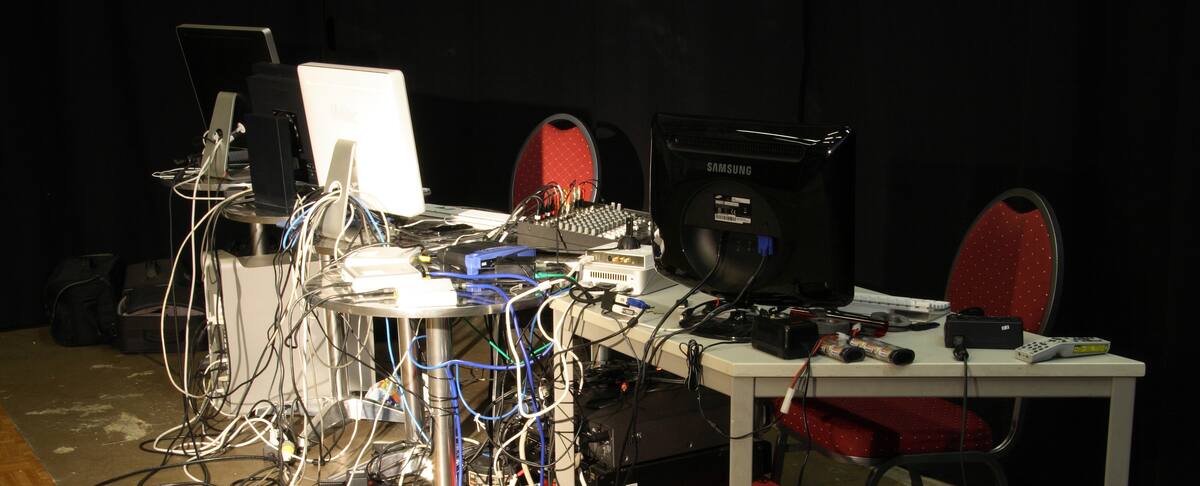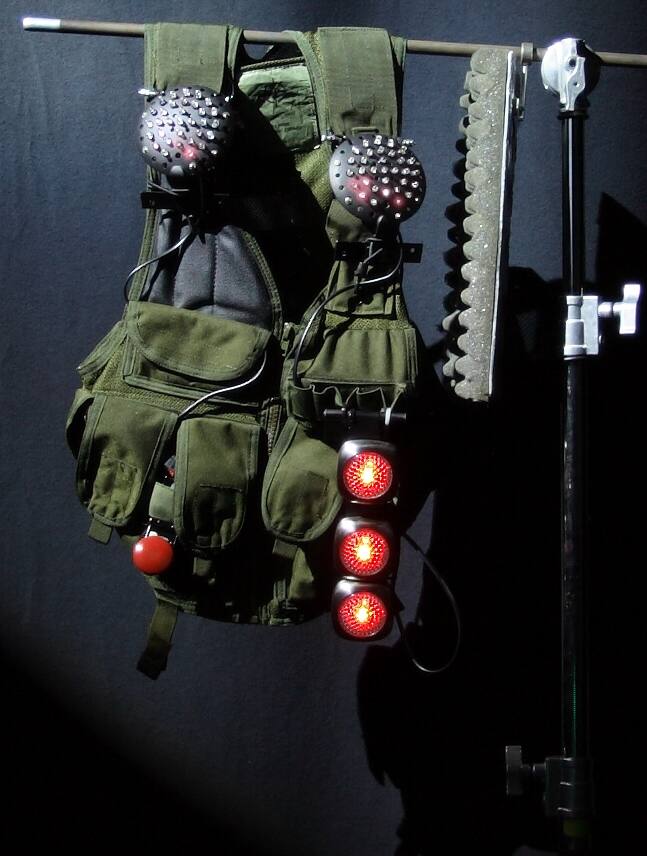Übergordnete Werke und Veranstaltungen
Vested
Personen
Media
Ryszard W. Kluszczynski
DON RITTER, Vested
Action and Responsibility
Since its very beginning, interactive art has developed in many directions, taken many forms and suggested a variety of strategies to its audience. Among its various forms we can find environments, in and with which the audience is invited to immerse itself and interact; screens showing content that responds to viewers’ behaviour; and multifunctional objects that attempt to assert their autonomy by initiating a game with their users. Each type of artwork makes use of the interface appropriate to it: sensors that monitor the audience’s movements, touch screens, graphic user interfaces, speech recognition software, and software able to read the psycho-physiological processes that take place in a human organism. Among the strategies on offer we find those that suggest using an interface as an instrument to generate audio-visual forms; those that engage the audience in various sorts of games; and those that invite the audience to explore archives, navigate hypermedia structures or participate in an interactive spectacle. The forms of action in which the audience is invited to participate range from executing/performing an artwork in line with a pre-prepared script through to creating one from scratch. Yet, regardless of the type of interactive art, of interfaces applied, or of strategies used to engage the audience, what we are dealing with in this discipline is a transformation of the traditional artwork-artefact into an artwork-event, the performative course, shape and effects of which are determined to a great degree by the audience’s actions.
Numerous interactive artworks offer their audience experiences of an abstract nature. They initiate meta-media or meta-artistic discourses, thereby suggesting that one focus on certain aspects of an interaction or on the aesthetic values of the audiovisual processes generated. Many of them even endeavour to take up other issues, immersing the recipient in philosophy, sociology or politics. Many such artworks began to appear in particular in the 1990s, which gave rise to the unfounded opinion that interactive art had only then matured sufficiently to undertake such activity, grown up enough to join in intellectual public debate.
Among the subjects addressed particularly often by interactive artists are those closely related to the nature of the means they use. These encompass all kinds of problems connected with the media itself, considered from a technological, institutional and social perspective, as well as the impact of media functions, including matters such as media convergence, the virtualization of reality, and media influence on cultural, individual and collective identity patterns. Subjects of special significance are those relating to interactivity itself, e.g. issues around the control and supervision exerted by interactive technologies, as opposed to concepts that emphasize their emancipatory potential.
A significant number of Don Ritter’s installations rank precisely among the aforementioned kinds of interactive art, though he also created artworks that belong to a more abstract stream of interactive art and grew out of his interest in the relations between image and sound. These installations comprise interactive, immersive environments, within which the audience engages in all kinds of activity: physical exercise, as in the installation Fit; or political speeches delivered live to a crowd (the virtual audience that subsequently reacts to them), as in Vox Populi. In every such case the audience is confronted with a certain form of pressure; the artwork creates a situation in which certain choices seem more appropriate, more desirable, more highly valued. The crucial feature of these artworks is the non-importunity of their persuasion; the recipient of the art is placed in a certain situation and takes actions that seem to him or her to ensue from a spontaneous decision, from his/her own unlimited options.
Michel Foucault once described such a process, in his analysis of the social processes that shape human identity and subjectivity, and thereby noted that the actions of one person or agency determine the potential range of action of another. Such power – the control exerted by means of ‘technologies of the self’ (to use Foucault’s term) – is acquired thanks to an individual’s gradual interiorization of regulatory systems, orders and obligations, which shapes his/her morality and self-knowledge, and embeds these deeply in the net of social relations, and – insofar as it is a means of modifying certain actions by other ones – necessarily demands freedom for those subject to it. Power and freedom, as Foucault emphasizes, are therefore not opposing but, rather, mutually influential and complex forces. Control can be exerted only over those who are free. Interactive technologies in which patterns of potential behaviour are encoded may thus be perceived as yet another illusory source of emancipation and freedom, one that continues to exert a subtle form of control by directing individuals’ seemingly autonomous actions. The forms of interface consequently chosen by Ritter – thanks to which the recipient is not compelled to use certain instruments but can navigate the artwork and move freely throughout its space – effectively heighten the impression of an absolute freedom of choice.
The installation Vested, in maintaining the structure described above, introduces the recipient into a context in which s/he may start to reflect on her actions. An artwork from the very moment at which a recipient enters its space, it acts as a particular system of persuasion. Spotlights function as an informative system that suggests a person entering the working circle undertake certain actions. The spotlights are a constant presence during recipients’ experience of the artwork and thus reveal their actual status as controller of the installation. Sensors manipulate the relationship between a recipient’s movements and changes in the designed images in order to encourage further actions, and the vest that had been put on earlier – thanks to its construction and the signals it emits – implies potential for fresh undertakings in spectacular screen explosions.
The character of the events that come about because of the performance attempted by the audience and the technological context within which they take place allow us to presume that the installation is assessing the modern world of mass media institutions, in which the only incidents that matter are those developed in accordance with catastrophic scenarios, and in which impetuosity becomes the most valued social feature. The installation does not draw attention to the media system however; it is focused rather, on those who appear to be neutral observers of these sudden events, and turn out to be also the beneficiaries of the pleasures derived from this spectacle of destruction. Their – culturally inculcated – tendency to find contentment in such events exposes their co-responsibility for the actions taking place and the world order in which they live.
Vested ranks among those artworks that attract recipients’ attention by means of spectacular events – which ensue in any case from the latter’s own actions – and induce them simultaneously to turn their attention to themselves. It is the recipients’ actions, the decisions they take, that comprise the real arena in which work is done; and it is here that the sense of the work is defined. Interactive technology provides the audience with an opportunity to take action and, at the same time, it hides from it the fact that the action unfolds in line with rules programmed earlier, as part of a formatted pattern. Ritter’s installation applies technological mechanisms so as to reveal cultural, internalized ones that pretend to be the mechanisms of an individual free will. By unveiling them, he offers recipients an opportunity to overcome them.


